Custom Manufacturing & Fabricating
What is 3D Printing and How Does it Work?
Share:
One of the most revolutionary ideas that have impacted manufacturing in the 21st century is the concept of 3D printing. Also known as additive manufacturing, 3D printing technology allows for the production of parts, structures, and products by using a layer-by-layer creation technique controlled directly from a set of design instructions powered by computer technology. This approach provides several advantages over more traditional manufacturing technologies that rely on cutting tools to remove material to fabricate a design with the desired dimensions and features as specified by a CAD model.
The market for 3D printing services has grown significantly since its conception in the early 1980s. According to data published by Statista, the global market size for 3D printing products and services was $12.6 billion in 2020 and is anticipated to reach $37.2 billion by 2026 (see Figure 1 below).
 Image credit: Statista.com
Image credit: Statista.com
Figure 1 - Global 3D Printing Market Size from 2020 to 2026
Advances in 3D printing as a manufacturing technology have led to increased demand for 3D printing services in Europe, as well as in many other parts of the globe.
In this article, we will provide an overview of 3D printing and address what it is, how it works, the various types of 3D printing technologies used, what type of materials can be used, and the products that can be created. To learn more about specific 3D printing technologies or materials, links are provided to related articles and guides where additional details are available.
What is 3D Printing?
3D printing is a term that is used to refer to a range of specific technologies that are capable of creating a design by adding material one layer at a time until a finished product has been produced. The term 3D printing likely evolved from one of the earliest technologies that was introduced in the field, known as Fused Deposition Modeling, abbreviated as FDM. This name was applied as the FDM technique worked very similarly to a 2D inkjet printer that sprays ink on paper in layers of a row at a time. It is also important to recognize that the earliest 3D printing technologies were geared more towards use in the consumer market as opposed to being thought of as having commercial value as industrial manufacturing technology1,2,3
The term additive manufacturing is a broader term that is generally more inclusive and is more often associated with the industrial applications of the technology such as prototyping or large-scale mass production of products as opposed to a more consumer or hobbyist-oriented use. While the underlying technologies may basically be the same, the size, throughput, speed, print resolution, and cost of machinery clearly will be different when an industrial or commercial application is being considered. Nonetheless in this article, we shall use these terms more or less synonymously. It should be mentioned that a third term sometimes used in connection with 3D printing is direct manufacturing, referring to the fact that the process involved creates parts “tool-free” directly from a CAD model design4.
Additive Manufacturing vs. Traditional (Subtractive) Manufacturing
The key difference that distinguishes 3D printing from traditional manufacturing technology is the use of an “additive” process versus a “subtractive” process.
Traditional manufacturing techniques that are used to fabricate parts are generally based on the idea that raw material is machined into the desired shape with required features using cutting tools. Thus, the raw material — sometimes referred to as a “blank” — is dimensionally larger than the desired end dimensions of the part and is “reduced” by a cutting process until the final dimensions are achieved. Hence the term “subtractive” is applied to these processes, whether they involve milling, turning, routing, drilling, or other machining techniques. Material is being removed by the process in order to create the proper size and features for the part.
3D printing, by contrast, is “additive” in nature. There is no blank used from which material is cut — instead, raw material is fed by the printer to be added a layer at a time as needed to fabricate the part. A 3-dimensional representation of the desired part or product that is taken from the CAD model is “sliced” into a series of thin vertical layers which are sequentially printed one on top of the next, with each layer joining with the ones above or below it to fuse together and form the end product. Depending on the printing technology used and the material from which the part is being created, there are some differences in the specifics, but broadly speaking, this description provides an understanding of the main distinction between the additive process of 3D printing versus the subtractive process of more traditional manufacturing, including CNC machining techniques.
Advantages of 3D Printing
By contrasting the additive process with the traditional subtractive process, several advantages of 3D printing over traditional manufacturing methods immediately become apparent.
Efficient Use of Material
Since the process of 3D printing does not use cutting tools to remove excess material in the way that subtractive processes do, there is an efficient use of material and less waste generated. Estimates are that around 98% of the material used in 3D printing winds up being used in the finished parts created. By contrast, a finding from the Oak Ridge National Laboratory indicated that as much as 30 pounds of material wind up as waste for every 1 pound of useful material in some parts.
Eliminates the Need for Lubrication and Cooling Fluids
Subtractive processes such as milling, routing, and turning involve the use of cutting bits to remove excess material, shape parts to the proper dimensions, and add features such as keyways, slots, and holes, for example. These cutting tools used often operate at high speed, are subject to frictional forces, thus requiring lubrication and cooling fluid to be applied to the workpiece and tooling to reduce tool wear. The techniques used with additive manufacturing eliminate this requirement to a large extent.
Greater Portability & Flexibility
The traditional machinery used in subtractive manufacturing operations has a large footprint and is not designed for portability. Hence production operations must be centralized, and parts must be shipped to where needed, adding delays and costs. Many 3D printers are smaller and can be easily deployed to remote locations, enabling part fabrication to be performed where it is needed — such as to fabricate replacement components wherever the end product or system is deployed.
Reduced Costs
Many traditional manufacturing processes such as casting, stamping, or molding, require upfront investment to be made in tooling such as die or mold creation whenever a new part is being developed for production. Furthermore, these initial costs can recur should there be a design change needed after the initial die or mold was produced. In the case of initial costs as well, the acquisition cost of high-performance CNC machinery used in traditional manufacturing can be significant.
Additive manufacturing, being a direct fabrication process, can create products without the intermediate step of needing to design and produce a mold or stamping die, thus saving the costs associated with the initial tooling steps found in traditional manufacturing. And the cost of acquiring a 3D printer is much less than the equivalent costs that would be incurred to purchase traditional machinery such as mills, lathes, and routers.
How Does 3D Printing Work?
The process for 3D printing a part or product begins with a graphic design representation of the object to be printed, usually in the form of a 3D CAD model. Before the 3D printer can begin printing the part, the graphic model needs to be processed through specialized software known as slicer software. As the name implies, this software utilizes the 3D model and generates a set of instructions for the printer by creating individual thin vertical layers or slices of the design. Depending on the complexity of the object being printed and the resolution of the printer, a large number of these layers are generated by the slicer software. The instruction set for creating each layer of the design is then sent to the printer sequentially, and the printer will use the instructions to print each layer of the design before moving on to the next layer. Gradually, the part or product is built up on top of a substrate as the print head or jets are directed to place material as needed to match the design features and dimensions. The substrate that holds the object has its vertical position shifted by a small amount after each layer is added, readying the printer for the addition of the next layer. The process continues until all layers are printed5,6.
One other key function of the slicer software is to add instructions for the creation of any support structure elements that are needed into the instruction set.6,9 These elements are not part of the original design but are essential when printing the object to assure that the final design features will appear as needed. Because 3D printing necessitates adding material that often has the consistency of a thick liquid or melted wax, the part won’t gain full structural stability until the material has cooled and cured into a solid. As an example, printing a part that contains an opening may require that a temporary support column be added since you can’t dispense fluid material across an air gap without it drooping or sagging. Once cooled, the support structures can be removed from the printed part as part of secondary finishing operations.
Because there are a number of different 3D printing technologies, the specifics of the printing process will differ depending upon the technology utilized by the specific printer. But generally, the description provided above gives a general idea of how 3D printing works and how a 3D printer creates parts from an initial graphic design.
The Different Types of 3D Printing Technologies
Since its origins back in the 1980s, the field of 3D printing has expanded and grown significantly. While Fused Deposition Modeling or FDM was one of the earliest methodologies developed, soon other newer technologies were developed and introduced into the marketplace. In 2012, ASTM International, which is headquartered in West Conshohocken, PA, created standard terminology by which the various 3D printing technologies could be characterized. They created seven broad categories associated with the discipline of additive manufacturing, which are:
- Material Extrusion
- Vat Photopolymerization
- Binder Jetting
- Powder Bed Fusion
- Directed Energy Deposition
- Material Jetting
- Sheet Lamination
Data from Statista illustrates the most used 3D printing technologies worldwide as of July 2018 (see Figure 2 below). A summary of the primary categories of 3D printing and examples of technologies that fit these categories appears below the figure.
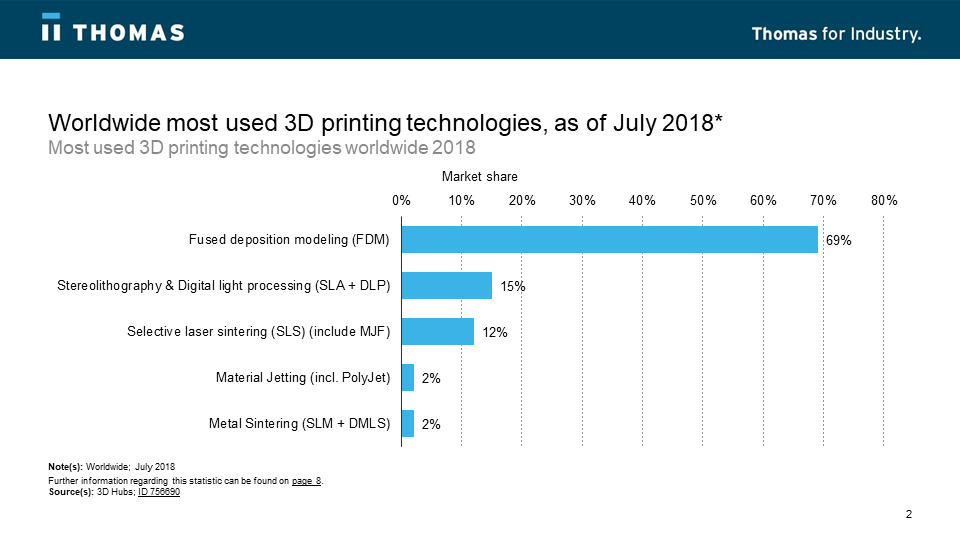 Image credit: Statista.com
Image credit: Statista.com
Figure 2 - Most Used 3D Printing Technologies Worldwide as of July 2018
Material Extrusion
With Material Extrusion, a thermoplastic material is fed into a heated nozzle and then deposited onto a substrate or surface that is called the build platform. Examples of specific technologies that fall under the category of Material Extrusion include Fused Deposition Modeling, or FDM, and Fused Filament Fabrication (FFF).
Vat Photopolymerization
Vat Photopolymerization starts with a liquid plastic material that is light sensitive, called a photopolymer, which is exposed to some form of light energy in a controlled manner to cure and harden the liquid polymer into the desired part. Several technologies of this type exist, each using a variation in the light-curing process, with some using an ultraviolet laser while others using light frequencies in the visible spectrum. Common Vat Photopolymerization techniques include Stereolithography (SLA), Digital Light Processing (DLP), and Continuous Liquid Interface Production (CLIP™).
Binder Jetting
Binder Jetting, or Binder Jet Printing, is a category of 3D printing that makes use of a liquid chemical bonding agent to join together particles of the base material that is typically in the form of a powder. Examples of technologies that use binder jetting include Powder Bed and Inkjet Head (PBIH) 3D Printing, Plaster-Based 3D Printing, and ColorJet Printing (CJP).
Powder Bed Fusion
Powder Bed Fusion processes are similar to those of binder jetting in that powdered or granular material is fused together to form the desired part. The key difference between the two categories is that powder bed fusion joins material by using a thermal process as opposed to a chemical binder. The thermal energy is supplied to the material using a laser, electron beam, or other methods depending on the specific technology of 3D printing that is used. These technologies enable 3d printing in metal, and the five most common examples that fall under the category of powder bed fusion include Selective Laser Sintering (SLS), Direct Metal Laser Sintering (DMLS), Selective Laser Melting (SLM), Electron Beam Melting (EBM), and Selective Heat Sintering (SHS).
Directed Energy Deposition
Directed Energy Deposition processes also use thermal energy to bind together material, but they do so with much higher energy levels and are used with metals that have higher melting temperatures than polymers. Among the technologies that fall under the category of directed energy deposition are Laser Metal Deposition (LMD) and Electron Beam Additive Manufacturing (EBAM).
Material Jetting
Material Jetting processes, as the name implies, make use of jets similar to those found in inkjet printers to spray thermoset photopolymer material onto the build platform and then cure the material using a UV light source. Some of these processes, also known as Multi Jet Fusion and Polyjetting, make use of multiple jets to apply material and have the ability to print parts made of several types of material easily, allowing for the creation of designs from different materials in a single printing operation. The most common materials jetting technology is known as Multi-Jet Modeling (MJM).
Sheet Lamination
The final category of 3D printing processes is known as Sheet Lamination. Sheet lamination joins together thin layers of material that are in the form of sheets using either chemical bonding agents or the use of ultrasonic welding, depending on the material used. The two most common examples of the sheet lamination process are known as Laminated Object Manufacturing (LOM) and Ultrasonic Consolidation (UC).
Table 1 below contains a summary of each of the seven 3D printing processes categories and shows the associated technologies that fall under each category. The table also provides a brief summary of how these printing technologies function and contains links to our related guides wherein a deeper understanding of each of these technologies may be found.
Table 1 - Summary of Common Additive Manufacturing Technologies
| 3D Printing Process | 3D Printing Technology | Brief Summary |
| Material Extrusion | Fused Deposition Modeling | Molten thermoplastics are deposited layer-by-layer to create the desired form. |
| Vat Photopolymerization | Stereolithography (SLA) | An SLA printing service exposes photopolymers or photosensitive thermoset polymers to (UV) laser light to cure the material. |
| Digital Light Processing (DLP) | Creates parts by using a digital micromirror device to form a digital image of a layer at a time and curing the layer with a blue light. | |
| Continuous Liquid Interface Production (CLIP™) | Uses the principle of oxygen-inhibited photopolymerization to allow objects to be generated in a continuous manner rather than built up in layers. | |
| Binder Jetting | Powder Bed and Inkjet Head (PBIH) 3D Printing | Makes use of a binding agent dispersed by a print head to bond together material. |
| Plaster-Based 3D Printing | Similar to PBIH but using plaster powder to create parts for display whose mechanical properties are less critical. | |
| ColorJet Printing (CJP) | Produces a finished part using a chemical binder whose outer surface can be colored to the desired shade. | |
| Powder Bed Fusion | Selective Laser Sintering Services (SLS) | Uses a laser beam as a thermal source to fuse material together layer-by-layer without reaching the melting temperature in the process. |
| Direct Metal Laser Sintering (DMLS) Services | Similar to SLS but for metal materials. Needs an enclosure filled with inert gas to prevent metal oxidation from occurring. | |
| Selective Laser Melting (SLM) | Fuses metal powder together using the thermal energy from a laser by allowing the material to reach its melting temperature. | |
| Electron Beam Melting (EBM) | Makes use of a high-powered beam of electrons to fuse together metal powder one layer at a time to form a part. | |
| Selective Heat Sintering (SHS) | Joins powdered material together using heat and pressure by sintering (heating to below the point of liquification). | |
| Direct Energy Deposition | Laser Metal Deposition (LMD) | Uses a laser to melt a small area of metal called a melt pool into which new metallic powder is added to form a part in layers. |
| Electron Beam Additive Manufacturing (EBAM) | Uses a beam of high-energy electrons to melt metal into which feedstock in wire form is added to the substrate. | |
| Material Jetting | Multi-Jet Modeling (MJM) | Makes use of several linear nozzles attached to a print head which is heated to deposit plastic resins that are then cured using a UV light. |
| Sheet Lamination | Laminated Object Manufacturing | Joins layers of material in sheet forms such as paper, plastic, or metal using adhesives to create a part. Popular for prototyping. |
| Ultrasonic Consolidation (UC) | Applies a high-frequency, low amplitude ultrasonic signal to metallic sheets to fuse them together without the need for a solid-to-liquid phase transition to take place. |
More information about the various 3D printing technologies and how they function may also be found by reviewing our companion guide Types of 3D Printing Technologies.
Materials Used in 3D Printing
The material of choice for use in 3D printers has historically been polymers, owing to their low cost, ductility, and ease of fabrication. Data, as published by Statista, shows that as of July 2018, around ¾ of the top used materials in 3D printing worldwide fall into this category (see Figure 3 below).
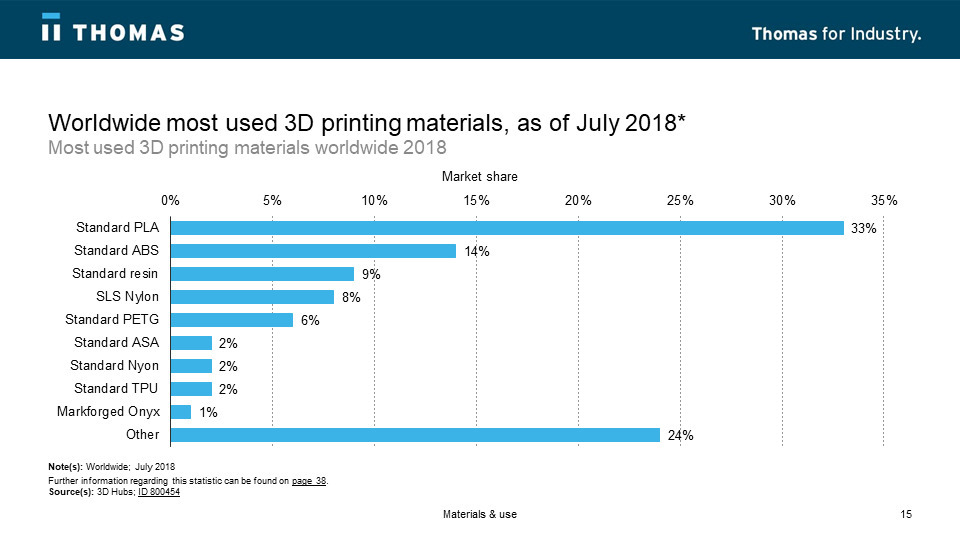 Image credit: Statista.com
Image credit: Statista.com
Figure 3 - Most Used 3D Printing Materials Worldwide as of July 2018
Advances in additive manufacturing processes have resulted in a broader range of material options being available for use today. This includes metals such as titanium and stainless steel, as well as ceramics and plaster. But as the use of 3D printing has grown to encompass more than just being an alternative for manufacturing parts, the list of materials used in printers has also expanded.
While plastics/polymers have led the way so far, other materials options are also demonstrating increases in their utilization. Data from Statista projected that growth in metals, ceramics, and other non-plastic/polymer options will exceed the compound annual growth rate (CAGR) of both these standard materials (see Figure 4 below).
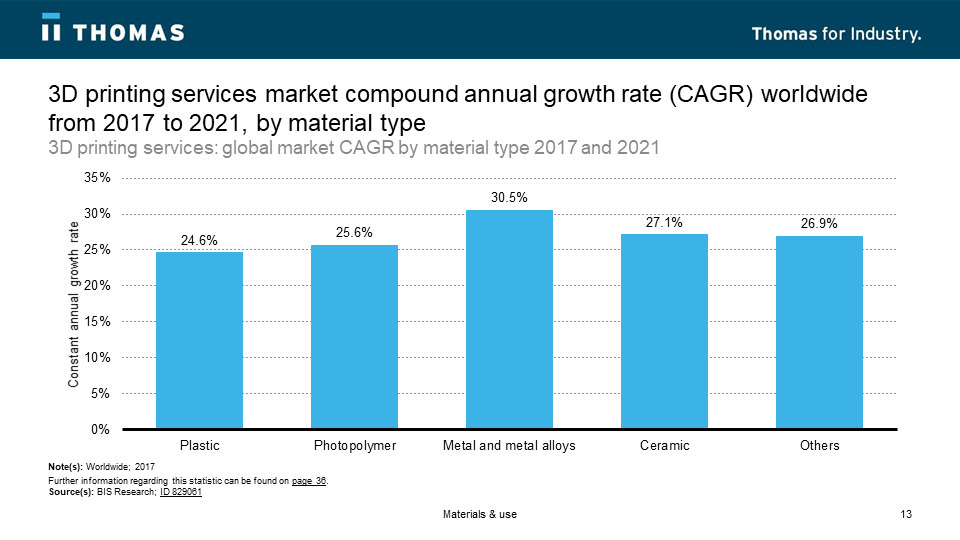 Image credit: Statista.com
Image credit: Statista.com
Figure 4 - 3D Printing Compound Annual Growth Rate From 2017 to 2021 for Different Material Types
Below is a brief look at many of the most frequently used material options in additive manufacturing. These materials have been grouped into plastics, powders, resins, metals, and others7,8,12.
Plastics
Common plastics used in 3D printing include the following:
- PLA, or Polylactic Acid, is an eco-friendly material that is produced from sources such as sugar cane or corn starch. It has a low melting temperature and is easy to work with.
- ABS, or Acrylonitrile Butadiene Styrene, is available in multiple color choices and is popular as a material for use by craftspeople and hobbyists. The material is sometimes known as "Lego Plastic" owing to its use in creating the toy blocks for which the Danish manufacturer is well known.
- PVA, or Polyvinyl Alcohol Plastic, is often utilized for printing temporary support structures that are to be dissolved later in post-printing operations. It is also used in low-end printers for home use to create decorative items where structural strength is not a requirement or for printing temporary use items.
- Nylon, also called polyamide, is a synthetically produced thermoplastic known for its durability, limited tendency to warp, and ability to accept dyes or to be colored. It is often used with FDM 3D Printing and FFF 3D Printing.
- PET/PETG, which stands for Polyethylene Terephthalate (with the G meaning glycol-modified), is used as a printing material in the modified form and offers flexibility, strength, and resistance to high temperatures and mechanical stress.
- PC, or Polycarbonate, is a material that requires printers with higher nozzle temperatures to be used.
- ASA, or Acrylonitrile Styrene Acrylate, is an alternative to ABS that is often used for printing automotive parts and offers a sturdy hard part that is durable
For FDM printers, these materials are typically in the form of filaments that have been extruded into thin cross-sections and wound on spools. More on 3D printing filaments can be found in our related guide Types of 3D Printer Filament and their Uses.
Resins
Resin materials are used with printing technologies that rely on curing material using light energy such as Stereolithography (SLA), Digital Light Processing (DLP), and Continuous Liquid Interface Production (CLIP™). These fall under the general category of Vat Photopolymerization described earlier, where the material is in a liquid state prior to being cured with UV light from a laser or other visible light frequencies.
Metals
3D printing with metals is performed using processes that produce higher thermal energy levels owing to the higher temperatures needed to sinter or fuse these materials into a solid part of the desired shape. Powder Bed Fusion technologies such as Selective Laser Sintering (SLS), Direct Metal Laser Sintering (DMLS), Selective Laser Melting (SLM), Electron Beam Melting (EBM), and Selective Heat Sintering (SHS) are used with metals. Also, Directed Energy Deposition technologies such as Laser Metal Deposition (LMD) and Electron Beam Additive Manufacturing (EBAM) can be used with metals.
Common metal material options include:
- Stainless steel
- Bronze
- Gold
- Nickel
- Aluminum
- Titanium
Depending on the specific printer technology, metals may be in the form of powders or wire feedstock.
Other Materials
There are other materials that are also used in 3D printing including graphene, graphite, carbon fiber, and specialty alloys such as nitinol, which is made from nickel and titanium and used in medical products.
Finishing Operations
Once the printing operation has concluded and the part has been removed from the 3D printer, some finishing operations may be required before the item can be utilized. The extent to which finishing is needed will depend on a host of factors including:
- The intended use of the item
- The specific process technology and printer type that was used
- The resolution of the printer
- The material used to print the part
- The drawing requirements on tolerance and finish
Based on survey data, Statista reported that for the period from 2017 to 2020, there was an increase in the number of survey participants that indicated a finishing operation was applied to 3D printed parts and products. These operations included polishing, painting, machining, heat treating, dyeing, varnishing, grinding, drilling, milling, turning, and others. Of note as well was the fact that for the last two years in the time window of the survey, just over 70% reported leaving the part raw, implying no finishing was applied. This might be an indication of improvements in process quality occurring over time that mitigated the need for finishing or it may represent a different outcome, such as a shift in the types of products produced away from those requiring finishing towards others where such secondary operations were not essential. Such might be the case when shifting to produce products for more decorative purposes as opposed to more functional use driven by engineering specifications on tolerances and surface flatness. It may also reflect the use of the technology for rapid prototyping and proof of concepts, where the primary concerns are less with the final appearance of the part and more so with whether the prototype as produced will meet the intended need.
Figure 5 below shows a line graph representation of the types of finishing used by year from 2017 to 2020.
 Image credit: Statista.com
Image credit: Statista.com
Figure 5 - Most Used 3D Printing Finishing Operations from 2017 to 2020
How is 3D Printing Used and What Can You Make With a 3D Printer?
Data from multiple sources point to the versatility of 3D printing as a technology that can be applied to a variety of industries and for the production of different types of products. One commonly cited use of the technology is the ability to create rapid prototypes for early engineering models and proof of concept design mockups.
Based on survey data reported by Statista covering the period from 2015 - 2020, those applications for which respondents acknowledged usage by the largest percentage included:
- Prototyping
- Proof of Concept
- Production
- Research/education/R&D
- Mechanical spare parts
- Tooling
Other uses less frequently cited include personal interest/hobbies, marketing sample creation, art/jewelry, and medical/dental devices/prostheses. Mass production was mentioned but was not as frequently cited (see Figure 6 below).
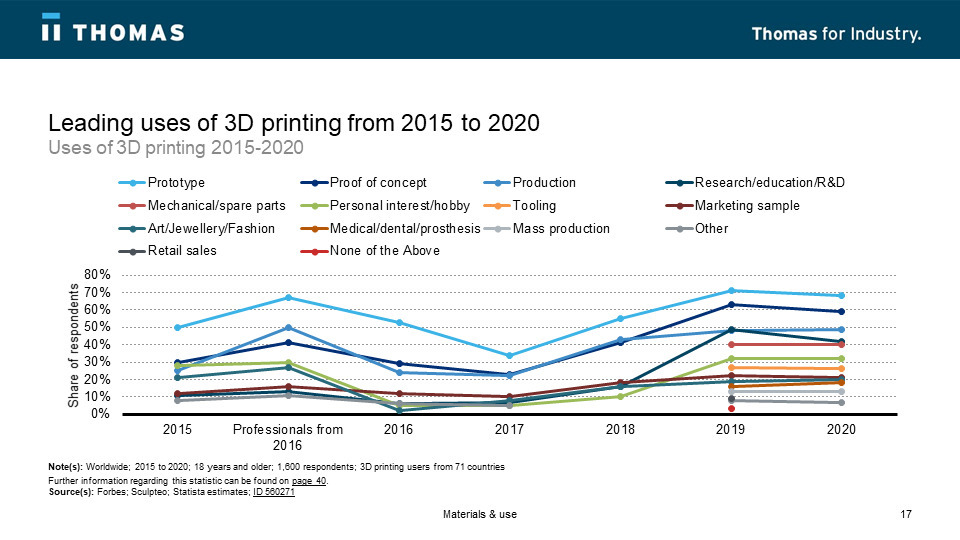 Image credit: Statista.com
Image credit: Statista.com
Figure 6 - Leading Uses of 3D Printing From 2015 to 2020
Other data published by Hubs, a Protolabs Company, in their Additive Manufacturing Trends Report 202110 sheds light on some additional trends relating to 3D printing relating to COVID-19 and in the usage of the technology in general. Among the findings reported from surveys were the following key data points summarized in the report:
- The pandemic may have slowed the growth rate of the market but did not stop slow its overall use. Some 50% of respondents stated that their usage stayed the same during COVID and 33% indicated that an increase in usage during the pandemic occurred.
- Users reported prototyping (47%), jigs & fixtures (21%), and aesthetic/functional end parts (29%) as the most frequently cited applications of 3D printing.
- Given these cited uses, 64% of 3D printing production runs were for between 1-10 parts, 22% for 11-50 parts, and 8% between 51-100 parts. This aligns with the primary usage cited earlier for prototyping and proof of concept printing. There is anticipated growth in the future for increased use of the technology as a vehicle for larger production runs.
- Finally, when queried about the barriers for greater use of 3D printing, respondents indicated that the leading factors which preluded greater use included:
- Cost being too expensive (38%)
- Quality of parts not being high enough (29%)
- Limited expertise (19%)
- Material choice options being small (14%)
It is interesting to note that there are additional applications for 3D printing in settings and industries outside of the traditional industrial manufacturing of parts. Among these is the use of 3D printing involving diverse materials such as concrete, human skin, and food.
- Construction firms have developed large-scale 3D printers that can create structures such as homes and bridges using concrete as a material.
- Researchers are experimenting with 3D printers to develop the means to use skin cells to create a printable ink that can create human skin with all of its intrinsic layers as an alternative means of generating tissue to assist burn victims.
- Clothing and shoe manufacturers see additive manufacturing as a means to allow customers to have fashion tailored to their needs, wishes, and sizes as an alternative to standard “off-the-rack” options.
- Food is being considered as another arena in which 3D printing will play an increasing role as kitchens begin to experiment with the use of 3D printers to produce edible food and unique shapes that could not otherwise be produced.
The future of the additive manufacturing field is ripe with possibilities to expand the scope and depth of what can be printed.
Types of 3D Printers
The different types of 3D printers that exist implement one of the printing technologies mentioned earlier. The price range and sophistication of the machines vary from low-cost models intended for consumer use all the way up to industrial 3D printers that can handle part production at higher volumes, part creation using metals, or requirements for tighter tolerance.
There are specific printer parameters and specifications that should be kept in mind when deciding on a 3D printer for an application. Printer manufacturers will often provide guidance in the form of web applications or downloadable white papers to help in understanding the landscape of the 3D printer market. One such example as provided by BCN3D11 suggests that general factors including these be evaluated against needs when considering a 3D printer for purchase:
- Build volume – determines the maximum dimensions of a model that can be printed.
- Layer resolution – represents the distance between successive layers on the Z-axis of the printer and determines the resolution of the model in the Z-axis.
- Hotend nozzle size – for FDM printers, this determines the fineness or resolution of the print in a given layer. Smaller nozzle sizes represent greater resolution and detail that can be printed in the X-Y plane.
- Printing speed – measures the rate at which material can be laid down or deposited to form the printed object. Slower speeds can produce higher quality the tradeoff being that longer print times are needed.
- Multiple extrusion – some printers are capable of providing multiple extruders that can support the ability to print with different materials or different colors simultaneously. It can also allow for the printing of needed support structures that allow for complex geometries to be printed.
- Printer materials – determine if the printer is compatible with the specific materials needed for the application.
- Print surface – the surface upon which the printed material is deposited, sometimes referred to as the build plate or the substrate.
- Software and firmware – understand which slicer software is supported by the printer and how much control is offered by the firmware.
More information about software options for 3D printing can be found in our related guide The Best 3D Printing Software in 2021.
Note that the specifications for printers will vary depending on the type of printing technology being utilized. The considerations above are general, but additional factors will apply when considering printers that operate using Vat photopolymerization for example. See our related guide on specific technologies for more information.
To learn more about specific 3D printers available in the market, investigate some of the picks found in the links below based on your price range and needs:
- The Best 3D Printers under $200
- Best 3D Printers under $300
- The Best 3D Printers Under $500
- The Best 3D Printers Under $1000
- The Best 3D Printers for Cosplay
- The Best 3D Printers for Miniatures
- The Best 3D Printer for Kids
- The Best Dual Extruder 3D Printer
- The Best Large Format 3D Printer
- The Best 3D Printer for Beginners
- The Best Cheapest 3D Printer
- The Best Industrial 3D Printer
Market Leaders in 3D Printing
Based on data reported by Statista and illustrated in Figure 7 below, the U.S. dominates the 3D printing market in terms of percentage of market share with around 38% as of July 2018. The U.S. has more than twice the market share of the next nearest country, the U.K. with 15.7%.
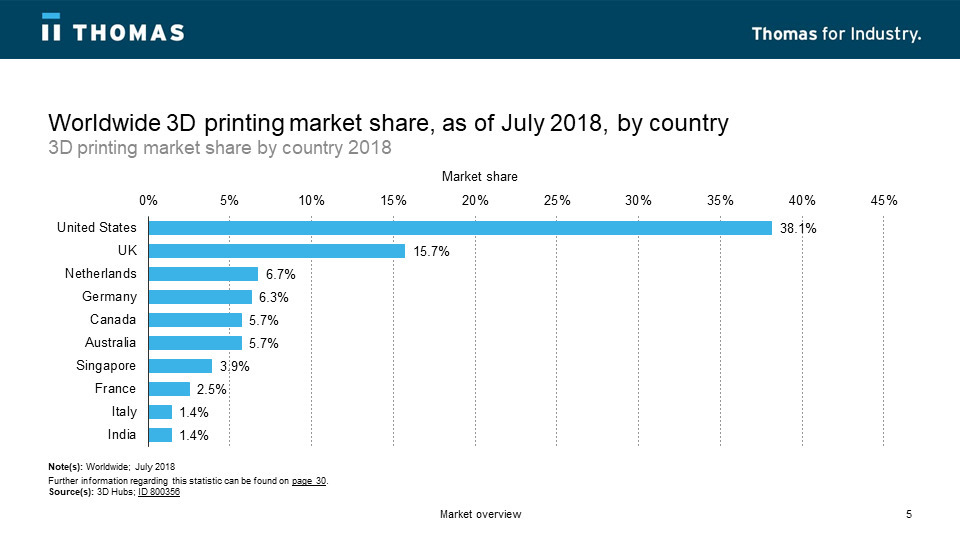 Image credit: Statista.com
Image credit: Statista.com
Figure 7 - Worldwide 3D Printing Market Share As of July 2018, By Country
Not surprisingly given its dominance, the leading owners of patent holders are also heavily represented by U.S.-based companies and educational organizations. Figure 8 below shows the leading organizations holding the largest number of patents relating to 3D printing, as of 2019.
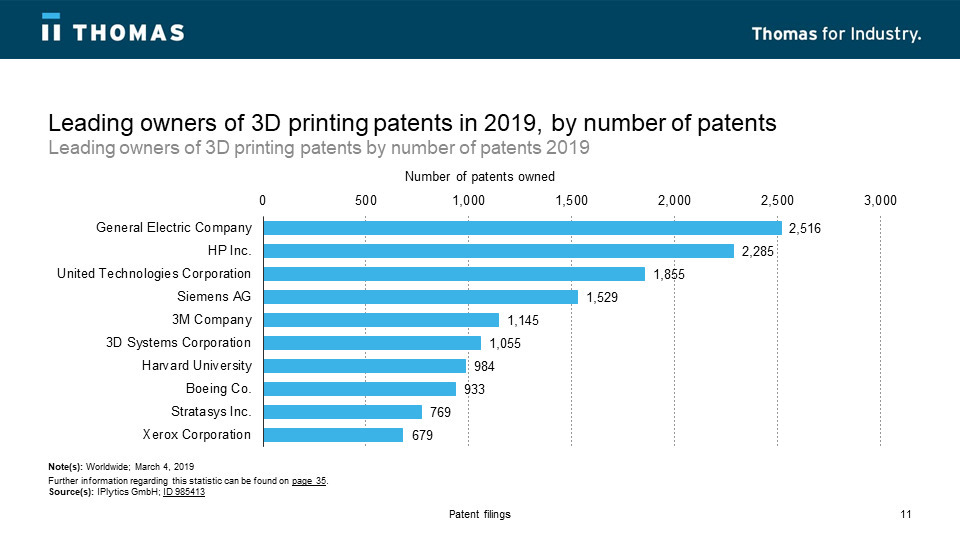 Image credit: Statista.com
Image credit: Statista.com
Figure 8 - Leading Owners of 3D Printing Patents as of 2019, by Number of Patents
Summary
This article provided a summary of the field of 3D printing, including what it is, how it works, the different technologies and materials that are used, as well as some of its applications and advantages. To learn more about this subject, review our related articles shown below or visit the Thomas Supplier Discovery Platform, where you can locate suppliers of additive manufacturing services, software, and materials such as metal powders.
Sources:
- Understanding 3D Printing
- https://builtin.com/3d-printing
- https://interestingengineering.com/how-exactly-does-3d-printing-work
- https://3dprinting.com/what-is-3d-printing/
- https://www.ge.com/additive/additive-manufacturing/information/3d-printing
- https://www.energy.gov/articles/how-3d-printers-work
- https://www.additive-x.com/blog/what-is-slicing-software-and-what-does-it-do/
- https://www.sharrettsplating.com/blog/materials-used-3d-printing/
- https://www.cmac.com.au/blog/top-10-materials-used-industrial-3d-printing
- https://www.loc.gov/preservation/digital/formats/fdd/fdd000504.shtml
- https://3d.bcn3d.com/typ-how-to-choose-3d-printer
- https://redshift.autodesk.com/what-materials-are-used-in-3d-printing/
- https://www.statista.com/
- https://www.harbec.com/blog_post/injection-molding-vs-3d-printing/
Other 3D Printing Articles
- Top 3D Printing Services Companies in the USA
- Origins of 3D Printing and Additive Manufacturing
- Overview of 3D Printing Technologies
- Top 3D Printing Manufacturers and Suppliers (Publicly Traded and Privately-Owned)
- Top Suppliers of Additive Manufacturing Consulting Services
- The Best 3D Printers under $300
- The Best 3D Printers under $200
- The Best 3D Printing Software
- The Best 3D Printer Under $1000
- The Best 3D Printer Under $500
- All About Material Jetting
- All About Multi Jet Modeling (MJM) 3D Printing
- All About Fused Deposition Modeling
- All About Stereolithography 3D Printing
- All About Photopolymerization
- All About Sheet Lamination/Laminated Object Manufacturing
- All About Electron Beam Additive Manufacturing
- All About Direct Energy Deposition 3D Printing
- All About Binder Jetting 3D Printing
- All About Powder Bed Fusion 3D Printing
- All About Direct Metal Laser Sintering 3D Printing
- All About Selective Laser Sintering 3D Printing
- All About Selective Laser Melting 3D Printing
- All About Selective Heat Sintering 3D Printing
- All About Digital Light Processing 3D Printing
- All About Continuous Liquid Interface Production
- All About Powder Bed and Inkjet Head (PBIH) 3D Printing
- All About Laser Metal Deposition 3D Printing
- The Best Petg Filament
- The Best 3D Printer Filament
- Types of 3D Printer Filament and their Uses
- The Best 3D Printer for Kids
- The Best Dual Extruder 3D Printer
- The Best Large Format 3D Printer
- The Best 3D Printer for Beginners
- The Best 3D Printing Books
- The Best Cheapest 3D Printer
- The Best 3D Printer Pens
- The Best Industrial 3D Printer







